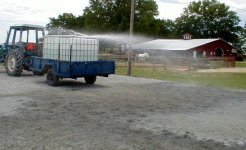patrickg
Veteran Member
I'm interested in firefighting with my CUT and was wondering what recommendations for PTO driven pumps, nozzles, etc I might get.
Pasture burning is experiencing a strong comeback as a management tool and I intend to employ it. To do so safely I need a good mobile water based fire suppression capability and my tractor is the best candidate.
I have a pasture spray rig but its accessory hose and nozzle is for spraying ag chemicals and is way too puny to use against a wind driven pasture fire. I was thinking along the lines of changing out the roller pump to a more capable unit and plumbing in the capabillity of using an alternate hose and nozzle.
I have been told the absolute minimum effective spray rig must supply more than 6-7 gal/min with at least 125 or more PSI through at least a 3/4 ID hose (1 inch being better.)
Horsepower to spin the pump isn't a problem as I have about 40HP @540 RPM at the PTO. I have seen a terrific 1 ton truck mounted fire suppression rig that simultaneoulsy operated two hoses larger than 3/4 inch ID and it had a 20 HP gas engine driven pump.
TIA for your consideration and comments,
Pat /forums/images/graemlins/smile.gif
Pasture burning is experiencing a strong comeback as a management tool and I intend to employ it. To do so safely I need a good mobile water based fire suppression capability and my tractor is the best candidate.
I have a pasture spray rig but its accessory hose and nozzle is for spraying ag chemicals and is way too puny to use against a wind driven pasture fire. I was thinking along the lines of changing out the roller pump to a more capable unit and plumbing in the capabillity of using an alternate hose and nozzle.
I have been told the absolute minimum effective spray rig must supply more than 6-7 gal/min with at least 125 or more PSI through at least a 3/4 ID hose (1 inch being better.)
Horsepower to spin the pump isn't a problem as I have about 40HP @540 RPM at the PTO. I have seen a terrific 1 ton truck mounted fire suppression rig that simultaneoulsy operated two hoses larger than 3/4 inch ID and it had a 20 HP gas engine driven pump.
TIA for your consideration and comments,
Pat /forums/images/graemlins/smile.gif

